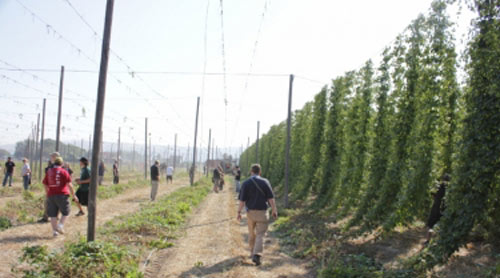The United States Department of Agriculture (USDA) just released its mid-year Acreage Report for 2018. The report outlines how many acres of each crop the nation’s farmers have planted this year. Crops like wheat, soy beans, corn and cotton are important, but so too are hops, especially if you’re a deeply afflicted beer enthusiast like me.
For those of us buried this deep in the weeds of beer geekery, this year’s Acreage Report is quite revealing.
First up, the size of the nation’s hop crop grew by about 2,000 acres. Hop farmers planted 55,339 acres of hops this year. Washington is growing approximately 71 percent of the U.S. hop crop this year, with Idaho growing approximately 15 percent and Oregon growing approximately 14 percent. The USDA only reports on hop acreage in those three states because the remainder is negligible.
Idaho surpassed Oregon in terms of overall hop acreage in 2018. For as long as I’ve paid attention, Oregon ranked second behind Washington in terms of hop production, with Idaho making up just a sliver of the nation’s overall hop production. Idaho farmers are growing 8,217 acres of hops this year, an increase of about 1,200 over 2017. Oregon farmers are growing 7,849 acres of hops this year, showing no significant change over 2017.
Another notable factoid from the report is the news that Citra has replaced Cascade as the top hop. That is, farmers planted more Citra than Cascade in 2018.
In Washington, Cascade acreage dropped from 4896 to 4124, a decrease of 772 acres. Cascade acreage dropped by about 100 acres in Oregon and by about 50 acres in Idaho.
In Washington, Citra acreage rose from 3,645 to 4,954, in Idaho from 759 to 855, and in Oregon from 716 to 843. In total, Citra acreage increased by more than 1,500 acres.
Some other hop varieties saw a noticeable drop in acreage. Centennial acreage dropped from 4305 to 3897 and Simcoe dropped from 3753 to 3098.
Two hops that saw an increase in acreage are Zeus and Columbus/Tomahawk, which leads us to the next point. One more bit of data gleaned from the report, most of the overall hop crop increase seems focused on alpha hops. Experts surmise that this is to make up for a recent shortage of these varieties.
If you’re still reading this, or if you find any of this at all interesting, you probably don’t need me to explain the difference between alpha hops and aroma hops.
A special thank you to Bart Watson of the Brewers Association for providing the report.

































